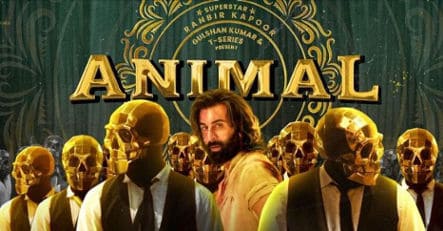A dissection of Animal, a movie that is Reddy’s toxic alpha ideology wrapped in daddy issues with an honorary bow of feminism.
If your highly stereotypical ‘Men will be Men’ ads were made into a movie, this would be it. Big gun toys (with a pinch of Aatmanirbhar Bharat), one man killing 500 other men while his friends (aka bhai) sing in the background, socially-approved infidelity that gets justified in the end, and crass humour that crosses all lines of decency in the name of being funny are just the tip of the iceberg with Sandeep Reddy Vanga’s Animal.
After the commentary and critique faced by Kabir Singh—for having too much unnecessary violence, for having a female lead that isn’t so much of a lead, and for that one slap—it seems like Vanga tried really hard to be accepted with his latest release. With its narrative of “a strong, independent woman” who is bold and actually questions the male lead, the movie tried to fulfil the “feminism quota” by adapting itself to the taste of its feminist critics but still (somehow) failed horribly. Maybe having the woman slap her husband rather than vice versa isn’t what feminism is about (aw, what a shock).
While the movie with its storyline had the potential to be impeccably emotional (cue a dysfunctional Sooraj Barjatya film), the mirch-masala of misogyny, subtle Nazi imagery (?), and alpha male toxicity only took away from the father-son dynamic the movie was trying to portray.
While Ranbir Kapoor’s character clearly had certain mental issues and a deep-seated desire for validation from his father (in common parlance, daddy issues), in a country plagued by a highly illiterate and influential population (read: padhe-likhe gawar), a movie like Animal became a spokesperson and an enabler, allowing not for an understanding of the character but rather a glorification of him, walking a precariously thin line as the audience fell in love with a son who just happens to be highly problematic. While the portrayal of such characters onscreen shouldn’t necessarily inspire its audience (watching Dahmer—the Monster didn’t make you want to be a serial killer, did it?), Ranbir Kapoor in Animal was advocated as the perfect green flag who does everything right (gaslighting 101), leaving little to be questioned about the “alpha” he was.
In the Vanga universe, the checklist for being the perfect male comes down to being pretty straightforward—raging anger issues? Check. Can it “turn on” with a snap of a finger? Check. Preaches about the superiority of being a man? Check. For a movie that wildly oscillated between a bloody rape scene and the (not so) boyish charm of snapping bra straps and pulling on one’s wife’s hair, it is as if Vanga had only one (albeit veiled) objective: wanting to present a picture-perfect image of all the problematic parts of the alpha male ideology.
As a woman, the movie felt like taking a walk in a shady area with no streetlights while a group of men catcalls you for three hours at regular intervals (as if the streets of Delhi weren’t enough). Under the guise of obsessive and possessive love, the movie tactically parceled and sold off misogyny and toxicity in bulk amounts. Every joke made, every blatant ignorance of the concept of consent, every misogynistic sprinkle of “love” and “strength” received ample validation from the snickers and the smirks of Ranvijay’s (Ranbir Kapoor’s character) friends, not so much different from the reaction of a majority of this animal-loving audience.
A dissection of the movie makes it clear that Animal are nothing if not driven by pure (poisoned) testosterone. The smartest feat of foreshadowing and direction in the movie? Opening with the definition of animal.
Read Also: Taali Review – An Exceptional Biopic Based on India’s Third Gender
Featured Image Credits: Onmanorama, filmfare
Manasvi Kadian







